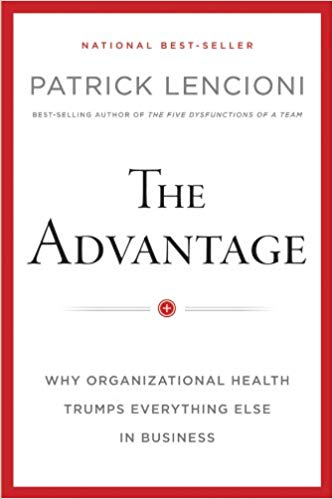
The single greatest advantage any company can achieve is organizational health. Yet it is ignored by most leaders even though it is simple, free, and available to anyone who wants it.
Patrick Lencioni
The Advantage: Why Organizational Health Trumps Everything Else in Business
What is organizational health?
Lencioni tells us that health occurs when an organization’s “management, operations, strategy and culture fit together and make sense”.
Any organization trying to maximize success must have two basic qualities: being smart and healthy.
Smart organizations excel at the fundamentals of business. They are good at strategy, marketing, finance and technology. They know how to gather information in order to make good decisions.
Information gathering in order to be smart can consume much of an organization’s time and resources. In the shuffle of information and decision making, the tasks of being healthy are forgotten.
How can we recognize a healthy organization?
Health is evident when we see signs that include:
- Minimal politics and confusion
- High degrees of morale and productivity
- Low turnover of good employees
What keeps leaders from tapping into the power of organizational health?
Lencioni says we have three biases to overcome.
The Sophistication Bias.
Creating a healthy organization is straightforward and uncomplicated. It doesn’t require expensive education or being uber-intelligent. It requires nothing fancy, just discipline, courage, persistence and common sense.
The Adrenaline Bias.
Leaders become addicted to the fire-fighting activity in their organizations. They are afraid to allocate time to deal with the important versus the urgent.
The Quantification Bias.
Analytical leaders who prefer hard data on whether goals have been met or not, have difficulty deciding what to measure in order to determine if their organization’s health goals are fulfilled.
What are the costs of an unhealthy organization?
Most of us have worked in an unhealthy organization and have dealt with the pain of politics, confusion, needless bureaucracy, and dysfunction.
Resources and time are wasted. Employee turnover is high. Customers leave. Productivity is below par. Loss of income. People seeing work as drudgery instead of joy. The list goes on and affects families and the larger community.
What does an organization have to do to become healthy?
Lencioni tells us there are four required disciplines:
- Discipline 1: Build A Cohesive Leadership Team
- Discipline 2: Create Clarity
- Discipline 3: Overcommunicate Clarity
- Discipline 4: Reinforce Clarity
In upcoming newsletters we’ll consider each of these four disciplines in order to understand the skills needed to create a healthy organization.
Suggested reading:
The Advantage: Why Organizational Health Trumps Everything Else in Business
by Patrick Lencioni

